#2: Humpty Dumpty Heart by LaVern Baker
City: Dauphin, MB
Radio Station: CKDM
Peak Month: September 1957
Peak Position in Dauphin ~ #3
Peak Position in Vancouver ~ did not chart
Peak Position on Billboard Hot 100 ~ #71
YouTube: “Humpty Dumpty Heart”
Delores Evans was born in 1929 in Chicago. Baker began singing in Chicago clubs such as the African-American Club De Lisa in 1946. She was often billed as Little Miss Sharecropper, and first recorded under that name in 1949. This led to a recording deal with that title for National Records in 1951, shortly before the label folded. She changed her name briefly to Bea Baker when recording for Okeh Records in 1951. She switched to Delores Baker, and then was billed as LaVern Baker when she sang with Todd Rhodes and his band in 1952. In 1953, she signed with Atlantic Records as a solo artist, her first release being “Soul on Fire”. In May 1953, LaVern Baker appeared at her first Alan Freed show, at the Cleveland Arena, along with the Drifters, the Spaniels, Faye Adams, and Roy Hamilton. Later that year she went on a 19-week tour of Europe. In September 1954, she performed at The Elbow Room in Windsor, Ontario. Her first hit came in early 1955, with the Latin-tempo “Tweedle Dee”, which reached number 4 on the R&B chart and #14 on the Billboard pop chart. It sold over one million copies.
Georgia Gibbs recorded a note-for-note cover of the song, which reached #1. Subsequently, Baker made an unsuccessful attempt to sue Gibbs for $250,000 (equivalent to $2,929,750 in 2024) and petitioned the US Congress to consider such covers copyright violations citing both Georgia Gibbs and Vickie Young as copying her arrangement and vocal style. Her request spurred Michigan African-American congressman, Charles Diggs, to lead a Congressional investigation into song theft.
In 1991, the Los Angeles Times reported, “Georgia Gibbs, reached in New York, still smarts from Baker’s flight insurance gibe. “It was a tragic thing that happened to black artists in the ‘50s,” concedes Gibbs, “but I don’t think I should be personally held responsible for it, because I had nothing at all to do with it. At that time, artists had no right to pick their own songs. I came into the studio and had no say at all about the background or the arrangement. To this day, I’ve never even heard her version of ‘Tweedlee Dee.’ ”
In April 1955, Baker performed on a show sponsored by Alan Freed at the Brooklyn Paramount. Others on the stage included the Penguins, the Moonglows, B.B. King and the Clovers. On November 20, 1955, Baker appeared on The Ed Sullivan Show. This broadcast introduced a largely white American TV audience to new sounds of R&B. Along with LaVern Baker, on that telecast were the Five Keys and Bo Diddley. In December 1955, Baker was again at an Alan Freed show in Manhattan along with the Cadillacs, Count Basie and others.
With her backing group, the Gliders (actually the Cues), LaVern Baker had more Top Ten hits including in 1955 “Bop-Ting-a-Ling” (#3 R&B), “That’s All I Need” (#6 R&B), and “Play It Fair” (number 2 R&B). In 1956, Baker was back in the R&B Top Ten with “Still” (#4 R&B) and “I Can’t Love You Enough” (#7 R&B). She experienced success with both pop and R&B audiences and was one of the key musicians creating cross-over success for R&B. She appeared in the 1956 film, Rock, Rock, Rock! Others in the movie included Chuck Berry, Johnny Burnette, Connie Francis, the Moonglows, the Flamingos, and Frankie Lymon & the Teenagers.
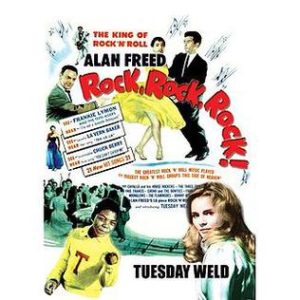
At the end of 1956, Baker had another hit with “Jim Dandy” which peaked at number-one on the R&B chart, and #17 on the Billboard Hot 100. It sold over one million copies by 1957. This was followed by “Jim Dandy Got Married”, which was a #7 R&B hit in early ’57. In October 1957, LaVern Baker appeared in the rock ‘n roll movie, Mr. Rock and Roll. She appeared alongside Chuck Berry, Alan Freed, Little Richard, Clyde McPhatter, Lionel Hampton, the Moonglows and Ferlin Husky.
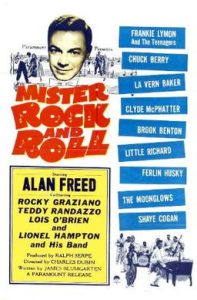
Meanwhile, LaVern Baker released “Humpty Dumpty Heart” late in the summer of ’57. The song was featured in Mr. Rock and Roll.
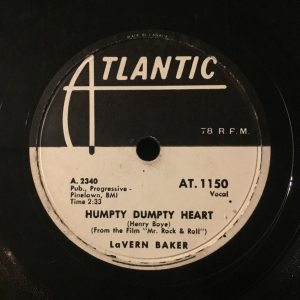
“Humpty Dumpty Heart” was written by Henry Boye for the film Mr. Rock & Roll. The lyrics are different from two songs with the same title: the 1941 Glenn Miller and His Orchestra tune by Johnny Burke and Jimmy Van Huesen, and the 1948 country song by Hank Thompson.
1) I’ve got a Humpty Dumpty heart…
I fell for you right from the start, a-ha.
Humpty Dumpty, Humpty Dumpty, Humpty Dumpty heart.
2) You’ve got me sitting on a wall…
Like a Humpty Dumpty I’m gonna fall…
Humpty Dumpty, Humpty Dumpty, Humpty Dumpty heart.
Bridge) All of your kissing, and all of your hugging
can’t put my heart together again.
3) I’ve got a Humpty Dumpty heart…
A heart your love has torn apart…
Humpty Dumpty, Humpty Dumpty, Humpty Dumpty heart.
“Humpty Dumpty Heart” is a riff off of the nursery rhyme delivered as a single quatrain:
Humpty Dumpty sat on a wall.
Humpty Dumpty had a big fall.
All the kings horses and all the kings men,
couldn’t put Humpty together again.
The lyrics above appeared in 1844 in The Orion children’s magazine. William Carey Richards discussed the English nursery rhyme in his article “Monthly chat with readers and correspondents.” An earlier version in 1810 was published in the English chapbook Gammer Gurton’s Garland: The Nursery Parnassus with these lyrics:
Humpty Dumpty sate on a wall,
Humpti Dumpti had a great fall;
Threescore men and threescore more,
Cannot place Humpty dumpty as he was before.
The original printed version of Humpty Dumpty in Samuel Arnold’s Juvenile Amusements provided these lyrics in 1797:
Humpty Dumpty sat on a wall,
Humpty Dumpty had a great fall.
Four-score Men and Four-score more,
Could not make Humpty Dumpty where he was before.
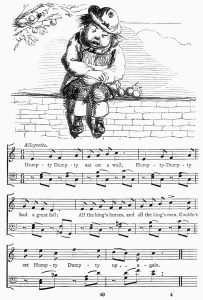
According to the Oxford English Dictionary, in the 17th century, the term “humpty dumpty” referred to a drink of brandy boiled with ale. The riddle probably exploited, for misdirection, the fact that “humpty dumpty” was also eighteenth-century reduplicative slang for a short and clumsy person. In 1842, the British humor and satire magazine, Punch, suggested jocularly that the rhyme was a metaphor for the downfall of Cardinal Wolsey. Just as Wolsey was not buried in his intended tomb, so Humpty Dumpty was not buried in his shell.
Humpty Dumpty also makes an appearance in Lewis Carroll’s Through the Looking Glass (1871). There Alice-in-Wonderland remarks that Humpty is “exactly like an egg”, which Humpty finds to be “very provoking” in the looking-glass world. Alice clarifies that she said he looks like an egg, not that he is one. They then go on discuss semantics and pragmatics when Humpty Dumpty says, “my name means the shape I am”.
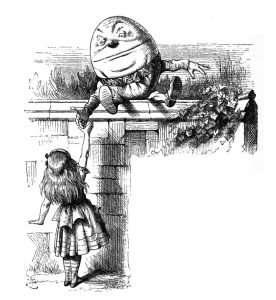
In the song, “Humpty Dumpty Heart”, the singer’s heart is broken in a state similar to Humpty Dumpty after he fell off the wall. A Humpty Dumpty heart can’t be put back together again.
“Humpty Dumpty Heart” peaked at #3 in New Orleans and Dauphin (MB), #5 in Boston, #6 in Houston, and #10 in Albany (NY).
Baker toured Australia in 1957 as part of Lee Gordon’s Big Show, performing with a number of rock ‘n’ roll bands including Bill Haley and His Comets, the Platters and Big Joe Turner. She also toured the West Indies, raising her international profile and becoming one of the most popular musicians in Jamaica.
In 1958, Baker had her biggest hit crossover record titled “I Cried A Tear”. It reached #2 on the R&B charts and #6 on the Billboard Hot 100. This was her one and only Top Ten hit on the pop charts. In 1959, “I Waited Too Long” was a #5 hit on the R&B chart. In May of 1961, she appeared with Louis Armstrong and Julie Wilson at New York’s Basin Street East jazz club. In 1962, she had her last Top Ten hit on the R&B chart with a cover of the 1924 Ma Rainey tune “See See Rider”, which had been a number-one R&B hit for the late Chuck Willis in 1957 (titled “C.C. Rider”). In June and July 1965, Baker pefformed at Gatineau Country Club in Ottawa.
Her last song to register as a pop hit on the Billboard charts was “Batman to the Rescue” in 1966, which bubbled beneath the Hot 100 at #135. She also recorded a duet with Jackie Wilson titled “Think Twice”.
In the late 60s’, Baker got pneumonia and was told to move to a warm climate. The June 24, 1970 Vincennes Sun-Commercial had an article titled “Lavern Baker To Leave Sunday For USO Tour”. In July 1970, she left for Southeast Asia to play military bases in Thailand, Okinawa, Manila, Tokyo, Guam, and Vietnam. In 1972, she settled in the Philippines and spent most of the next two decades there managing a club near the U.S. military base and performing on weekends. Her first return to the United States was for Atlantic’s 40th birthday party in 1988, where she performed in Madison Square Garden. In 1990, she appeared on Broadway in the musical Black and Blue. In 1991, LaVern Baker was inducted into the Rock and Roll Hall of Fame. Others inducted that year, in the shadow of the Persian Gulf War, were Ike and Tina Turner, John Lee Hooker, Wilson Pickett, the Impressions, and the Byrds.
Baker died at the age of 67 in 1997 of cardiovascular disease.
August 26, 2024
Ray McGinnis
References:
Marv Goldberg, “LaVern Baker,” 2001, and 2020.
Jacob Uitti, “Behind the Meaning of ‘Humpty Dumpty’, the Nursery Rhyme,” American Songwriter, 2022.
Peter Watrous, “Rock and Roll Hall of Fame Inducts its 6th Class of Legends,” New York Times, January 17, 1991.
Jon Pareles, “LaVern Baker Is Dead, at 67; A Rhythm and Blues Veteran,” New York Times, March 12, 1997.
LaVern Baker, “Tweedle Dee“, The Ed Sullivan Show, November 20, 1955.
“LaVern Baker,” Famoussingers.org, September 2015.
John Milward, “POP MUSIC : Everything’s Just Jim Dandy : R&B; veteran LaVern Baker has returned from two decades of obscurity to wind up on Broadway and in the Rock Hall of Fame. ‘I was able to keep my head up high and still be Miss Baker,’ she says,” Los Angeles Times, April 14, 1991.

CKDM 730-AM Dauphin (MB) Top Ten | September 21, 1957

Leave a Reply